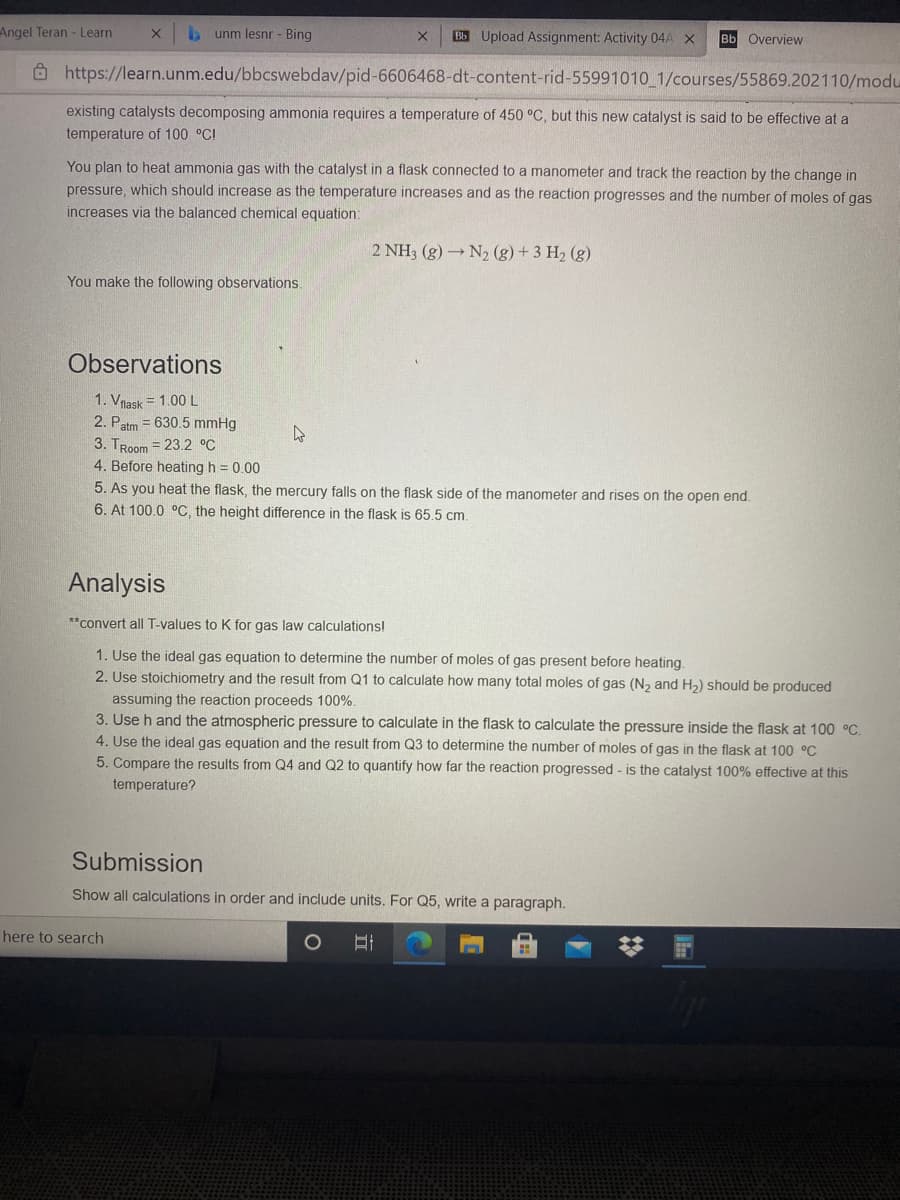Chemistry for Engineering Students
4th Edition
ISBN:9781337398909
Author:Lawrence S. Brown, Tom Holme
Publisher:Lawrence S. Brown, Tom Holme
Chapter11: Chemical Kinetics
Section: Chapter Questions
Problem 11.50PAE
Related questions
Question
Answer Analysis question 1-5 thank you ❤️

Transcribed Image Text:Angel Teran - Learn
unm lesnr - Bing
Bb Upload Assignment: Activity 04A X
Bb Overview
Ô https://learn.unm.edu/bbcswebdav/pid-6606468-dt-content-rid-55991010_1/courses/55869.202110/modu
existing catalysts decomposing ammonia requires a temperature of 450 °C, but this new catalyst is said to be effective at a
temperature of 100 °C!
You plan to heat ammonia gas with the catalyst in a flask connected to a manometer and track the reaction by the change in
pressure, which should increase as the temperature increases and as the reaction progresses and the number of moles of gas
increases via the balanced chemical equation:
2 NH3 (g) N2 (g) +3 H2 (g)
You make the following observations.
Observations
1. Vnask = 1.00L
2. Patm = 630.5 mmHg
3. TRoom = 23.2 °C
4. Before heating h = 0.00
5. As you heat the flask, the mercury falls on the flask side of the manometer and rises on the open end.
6. At 100.0 oC, the height difference in the flask is 65.5 cm.
Analysis
**convert all T-values to K for gas law calculations!
1. Use the ideal gas equation to determine the number of moles of gas present before heating.
2. Use stoichiometry and the result from Q1 to calculate how many total moles of gas (N2 and H2) should be produced
assuming the reaction proceeds 100%.
3. Use h and the atmospheric pressure to calculate in the flask to calculate the pressure inside the flask at 100 °C.
4. Use the ideal gas equation and the result from Q3 to determine the number of moles of gas in the flask at 100 °C
5. Compare the results from Q4 and Q2 to quantify how far the reaction progressed - is the catalyst 100% effective at this
temperature?
Submission
Show all calculations in order and include units. For Q5, write a paragraph.
here to search
Expert Solution
This question has been solved!
Explore an expertly crafted, step-by-step solution for a thorough understanding of key concepts.
This is a popular solution!
Trending now
This is a popular solution!
Step by step
Solved in 5 steps

Knowledge Booster
Learn more about
Need a deep-dive on the concept behind this application? Look no further. Learn more about this topic, chemistry and related others by exploring similar questions and additional content below.Recommended textbooks for you

Chemistry for Engineering Students
Chemistry
ISBN:
9781337398909
Author:
Lawrence S. Brown, Tom Holme
Publisher:
Cengage Learning

Chemistry: The Molecular Science
Chemistry
ISBN:
9781285199047
Author:
John W. Moore, Conrad L. Stanitski
Publisher:
Cengage Learning

Chemistry by OpenStax (2015-05-04)
Chemistry
ISBN:
9781938168390
Author:
Klaus Theopold, Richard H Langley, Paul Flowers, William R. Robinson, Mark Blaser
Publisher:
OpenStax

Chemistry for Engineering Students
Chemistry
ISBN:
9781337398909
Author:
Lawrence S. Brown, Tom Holme
Publisher:
Cengage Learning

Chemistry: The Molecular Science
Chemistry
ISBN:
9781285199047
Author:
John W. Moore, Conrad L. Stanitski
Publisher:
Cengage Learning

Chemistry by OpenStax (2015-05-04)
Chemistry
ISBN:
9781938168390
Author:
Klaus Theopold, Richard H Langley, Paul Flowers, William R. Robinson, Mark Blaser
Publisher:
OpenStax


Chemistry
Chemistry
ISBN:
9781305957404
Author:
Steven S. Zumdahl, Susan A. Zumdahl, Donald J. DeCoste
Publisher:
Cengage Learning

Chemistry: An Atoms First Approach
Chemistry
ISBN:
9781305079243
Author:
Steven S. Zumdahl, Susan A. Zumdahl
Publisher:
Cengage Learning